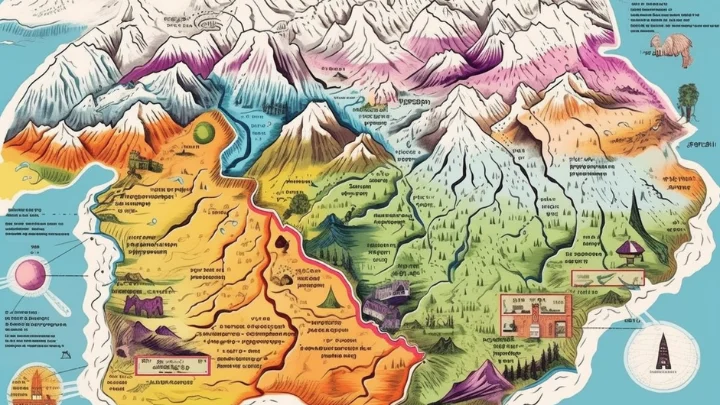This post may contain Amazon affiliate links which means, as an Amazon Associate, I may receive a small commission from purchases made through these links at no cost to you. I only recommend products I have personally used. To learn more, please see my privacy policy page.
The Wakhan Corridor, a narrow strip in northeastern Afghanistan, borders Tajikistan, Pakistan, and China. It’s renowned for its rugged terrain, strategic location, and rich cultural heritage, serving as a crossroads of civilizations in Central Asia.
Key Words
- Afghanistan
- Biodiversity
- Borders
- Central Asia
- Climate
- Ecotourism
- Geopolitics
- Silk Road
- Topography
Join me as we explore the heart of Central Asia. From its ancient trade routes to its strategic importance in global geopolitics, the Wakhan Corridor offers a fascinating study of geography’s impact on history and culture. Read on…
Introduction to the Wakhan Corridor
Nestled in the remote northeastern part of Afghanistan, the Wakhan Corridor is a narrow strip of land that extends like a panhandle, separating Tajikistan from Pakistan and brushing the borders of China. This geographical oddity, covering about 350 km in length and varying between 13 to 65 km in width, is framed by the majestic Pamir and Hindu Kush Mountain ranges. The corridor is defined by rugged, mountainous terrain and a harsh, yet strikingly beautiful landscape, characterized by high-altitude valleys, glacial rivers, and sparse vegetation. It serves as a natural conduit between the high mountains, creating a unique ecological and geographical zone.
The historical significance of the Wakhan Corridor is as profound as its geographical features. Historically, it was a critical part of the ancient Silk Road, serving as a trading and cultural exchange route that connected East and West. This slender land corridor witnessed caravans carrying silk, spices, and other treasures, and it was trodden by some of history’s most notable figures, including Marco Polo. The Corridor’s strategic importance was recognized in the 19th century during the Great Game, a political and diplomatic confrontation between the British Empire and the Russian Empire for control over Central Asia. It was then that the Wakhan Corridor became a buffer zone, a role it somewhat maintains even today.
Despite its harsh and inaccessible terrain, the Wakhan Corridor has been a melting pot of various cultures and civilizations. Its isolation helped preserve many ancient traditions and lifestyles, making it not just a geographical wonder but also a living museum of cultural heritage. The Wakhan Corridor remains a testament to the enduring impact of geography on human history, standing as a silent witness to centuries of trade, conquests, and cultural exchanges.

Physical Geography of the Wakhan Corridor
Topography and Climate
The Wakhan Corridor is a land of extremes, characterized by its rugged and diverse topography. The region is dominated by some of the world’s highest mountain ranges the Pamir and Hindu Kush. These colossal ranges create a dramatic landscape of towering peaks, deep valleys, and sprawling glaciers. The area’s altitude varies dramatically, from about 2,500 meters (8200 feet) in the west to over 4,000 meters (13100 feet) in the east.
The climate of the Wakhan Corridor is as varied as its topography. It experiences harsh, long winters with heavy snowfall, and brief, cool summers. The high altitude and mountainous terrain result in significant climatic variations over short distances. These conditions make the region challenging for habitation and agriculture but create a unique ecological niche.
Flora and Fauna
Despite its harsh climate, the Wakhan Corridor is home to a remarkable array of flora and fauna. The vegetation is typically sparse, consisting mainly of high-altitude grasslands, shrubs, and scattered forests in lower elevations. These ecosystems support a diverse wildlife population.
The region is particularly known for its population of the elusive snow leopard, a symbol of the wild and untamed nature of the high mountains. Other notable fauna includes the Marco Polo sheep, known for their impressive horns, the ibex, wolves, and brown bears. The biodiversity of the area is significant not only for its uniqueness but also for its role in conservation efforts, with several species being either endangered or under threat.
Major Rivers and Mountain Ranges
The Wakhan Corridor is crisscrossed by several major rivers, the most prominent being the Wakhan River, which flows through the corridor and joins the Panj River, forming part of the Amu Darya basin. These rivers are vital for the region’s ecology, supporting both the wildlife and the sparse human settlements.
The corridor is framed by towering mountain ranges. The Pamir Mountains, often referred to as the “Roof of the World,” lie to the north, while the Hindu Kush range defines the southern boundary. These mountain ranges are not just significant geographical features but also play a crucial role in the regional climate and are central to the cultural and historical identity of the region.

Cultural Landscape of the Wakhan Corridor
Ethnic Groups and Languages
The Wakhan Corridor is as culturally rich as it is geographically unique. It is primarily inhabited by the Wakhi and Kyrgyz people, each with their distinct languages and cultural practices. The Wakhi people, who live in the lower parts of the corridor, speak Wakhi, a language belonging to the Eastern Iranian group of the Indo-European family. Their culture is deeply influenced by their Ismaili Muslim faith and their long history in the region.
In the higher, more remote areas, the seminomadic Kyrgyz people maintain their distinct lifestyle. The Kyrgyz language, part of the Turkic language family, reflects their ties to Central Asian nomadic cultures. Despite the harsh living conditions, these communities have preserved their unique cultural identities, languages, and traditions over centuries.
Traditional Lifestyles and Customs
Life in the Wakhan Corridor is shaped by the harsh environment and the need for self-sufficiency. The Wakhi people primarily engage in subsistence farming and animal husbandry, adapting their practices to the high altitude conditions. They are known for their yaks and sheep, essential for transportation, clothing, and food.
The Kyrgyz communities, with their nomadic traditions, move seasonally with their herds, living in portable yurts. Their lifestyle reflects the broader Central Asian nomadic culture, emphasizing pastoralism and a deep connection with the land.
Both the Wakhi and Kyrgyz have rich cultural traditions, including music, poetry, and dance, which are often intertwined with their daily activities and religious practices. These traditions are not just forms of entertainment but are crucial for preserving their history and identity.
Influence of the Silk Road
The Wakhan Corridor’s history as part of the Silk Road has left an indelible mark on its cultural landscape. As a historical trade route, it facilitated not just the exchange of goods but also ideas, religions, and cultures between the East and West. This intersection of civilizations is evident in the region’s art, music, and cultural practices, which bear traces of Islamic, Turkic, and East Asian influences.
The Silk Road’s legacy in the Wakhan Corridor is also reflected in the diversity of its religious practices and the syncretism seen in local beliefs. This blend of cultural influences has endowed the Wakhan Corridor with a unique cultural richness, making it a living museum of Central Asian history and tradition.

Political and Strategic Importance of the Wakhan Corridor
Historical Conflicts and Alliances
The Wakhan Corridor has been a significant geostrategic region throughout history. During the era of the Great Game in the 19th century, it emerged as a critical area in the rivalry between the British and Russian empires. Its creation as a buffer zone between these two powers prevented direct conflict and maintained a delicate balance in the region. This geopolitical maneuvering highlighted the corridor’s strategic importance, laying the groundwork for its role in modern geopolitics.
Throughout history, the corridor has seen various local and regional powers vie for control, influenced by its strategic location as a gateway between Central Asia and South Asia. These historical conflicts and alliances have shaped the corridor’s political landscape, embedding it with a complex tapestry of regional dynamics.
Current Geopolitical Significance
In contemporary times, the Wakhan Corridor maintains its geopolitical significance, albeit in a different context. Its location at the confluence of several major powers – Afghanistan, China, Tajikistan, and Pakistan – continues to make it a region of strategic interest. The corridor offers a potential route for trade and energy pipelines, making it a focal point in discussions about regional connectivity and economic development.
Moreover, in the context of global security, the Wakhan Corridor’s relative isolation and difficult terrain have made it a point of interest in discussions about counterterrorism and border security. The region’s stability is crucial for the broader security of the Central Asian region.
Border Dynamics with Neighboring Countries
The Wakhan Corridor’s unique position, bordering three different countries, creates complex border dynamics. Each border represents different political, economic, and cultural relationships. With Tajikistan, there’s a shared cultural and linguistic connection, particularly with the Wakhi people. The border with China, though less traversed due to the harsh terrain, has historical significance and potential for future trade links.
The corridor’s border with Pakistan, particularly the narrow Wakhan Strip that approaches the Pakistani territory of Gilgit Baltistan, is of significant interest due to its proximity to the volatile Kashmir region. This border area, while remote, is a point of strategic concern for both countries, reflecting broader regional security and geopolitical interests.

Challenges and Opportunities in the Wakhan Corridor
Economic and Developmental Challenges
The Wakhan Corridor faces significant economic and developmental challenges. Its remote location, harsh climate, and difficult terrain make it one of the most inaccessible regions in the world. These factors hinder infrastructural development, limiting access to basic services like healthcare, education, and transportation for the local population. Economic activities are primarily confined to subsistence agriculture and animal husbandry, offering limited opportunities for growth or diversification. Additionally, the region’s political instability and security concerns further complicate efforts towards sustainable development and economic prosperity.
Ecotourism Potential
Despite these challenges, the Wakhan Corridor possesses immense potential for ecotourism. Its stunning natural beauty, unique wildlife, and rich cultural heritage make it an attractive destination for adventure tourism. The region’s untouched landscapes offer opportunities for trekking, mountaineering, and wildlife watching. Developing ecotourism in the Wakhan Corridor could provide a sustainable economic model, creating jobs and income for local communities while promoting conservation and cultural preservation. However, this potential needs to be balanced with the need to protect the fragile ecosystem and the traditional way of life of the local communities.
Conservation Efforts
Conservation in the Wakhan Corridor is crucial due to its unique biodiversity and ecological significance. Efforts are being made to protect endangered species like the snow leopard and Marco Polo sheep, as well as to conserve the region’s fragile high-altitude ecosystems. These efforts often involve collaborations between local communities, government agencies, and international conservation organizations. Community based conservation initiatives have been particularly effective, empowering local people to take an active role in protecting their natural heritage. These efforts are not only vital for biodiversity conservation but also for ensuring the sustainability of the region’s natural resources, which are fundamental to the livelihoods and culture of the local populations.
Wrap Up...
As we look towards the future of the Wakhan Corridor, it stands at a crossroads of potential and challenges. The corridor’s future is deeply intertwined with the broader geopolitical and economic dynamics of Central Asia. Its strategic location, rich cultural heritage, and unique biodiversity make it a region of significant interest, not just for the neighboring countries but for the global community.
The corridor’s potential as a hub for ecotourism and a model for community-based conservation offers a pathway to sustainable development. However, realizing this potential requires careful balancing of economic interests with environmental and cultural preservation. There is a growing recognition of the need to develop the region in a way that respects its ecological limits and benefits the local communities.
In terms of its geopolitical role, the Wakhan Corridor continues to be a region of strategic importance in Central Asia. Its stability and development are crucial for regional security and cooperation. The corridor, with its unique position bordering several key countries, could play a pivotal role in fostering regional connectivity and understanding.
The future of the Wakhan Corridor, therefore, is not just about the preservation of a remote and beautiful region but also about its potential to contribute to peace, stability, and sustainable development in Central Asia. The decisions made today regarding the Wakhan Corridor will have implications far beyond its rugged mountains and valleys, affecting the geopolitical landscape of an entire region.


